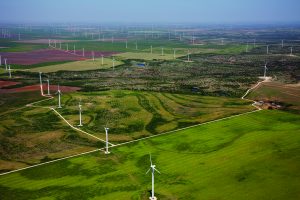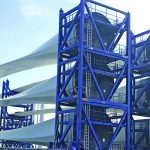In the January issue we noted that 2010 promises to be a challenge for the wind power industry as general equipment availability and transport capacity begins to tighten up, placing additional constraints on supply chains. As more countries enter the market, the shortage of equipment to transport and to erect wind farms will be felt on a global basis in the second half of 2010 and into 2011. This is due to three converging issues:
1) Projects already planned for this year;
2) Projects that were delayed from last year for financial and other reasons, and;
3) New regional and global companies entering the market.
Many countries are deciding to focus on renewable energy, particularly green energy, to meet their increasing demand for electricity. Countries such as South Korea are investing in, as well as entering the market, and Hyundai and Daewoo shipyards recently joined the drive for renewable energy. Plus, the South Korean government is investing billions to bring companies up to par with the current global players. One of their projects in Canada is expected to supply 1,000 wind turbines in 2011.
According to the China Renewable Energy Society, the total wind power capacity installed in that country is anticipated to reach 20 million kW this year. International consulting firm Frost & Sullivan recently estimated the cumulative installed capacity of China wind power to exceed 100 million kW in 2020, a compound growth rate between 20-30 percent from 2009 to 2020.
Meanwhile, in Europe, project developers in the northeast of England are looking for companies to invest in the region because of the higher demand for offshore services in the North Sea. The UK government seeks to increase the amount of wind-driven electricity generation by five times within a decade to help reduce the nation’s carbon emissions and to produce about 32 GW of electricity by 2020. This presents logistical challenges, as many of the offshore sites are in depths of up to 60 meters and in some instances are far from land. As many as 10,000 wind turbines, based on current technology, may be necessary to meet their plan of 32 GW, which means installing around 1,000 a year.
All this activity means that wind energy companies will be competing for capacity, especially as new players increase the demand for equipment. And as more wind power construction companies enter the market, demand will outstrip supply, creating a world shortage of transportation sources and logistics expertise. Currently, for example, there are only so many ships that can handle some wind power components, and plans to build massive 10 MW turbines are already under way, which means blades will increase in size. This places additional pressure on transportation capacity and the necessary equipment to handle large components. Vessels must be able to accommodate the larger equipment, as well as the increased volumes. Before the increase in equipment sizes, larger quantities of components could be loaded on a ship. That is changing. Construction barges for offshore farms are in short supply. Laydown areas have to be bigger because of higher volumes of shipments at the ports. The list goes on.
Market changes and equipment challenges demand a high level of logistics management expertise. Wind power companies that focus on and invest in the right resources will be in a leadership position in the future marketplace. Planning processes must be in place, including operational processes that can help smooth out the inevitable bumps of transportation equipment volatility. Dealing only with local resources often requires extensive management and could result in sourcing problems. Look for a wind power logistics solutions developer that can bring all the necessary partners to the table, preferably a company with global reputation and reliable infrastructure; a company with global sourcing capabilities, depth of knowledge, local expertise, and a wide range of transportation and port partnerships.





































